SAVE ENERGY, REDUCE EMISSIONS
Top tips to cope with rising energy prices
As of this financial year, households can expect to be paying more for energy. But there are plenty of things you can do to help minimise the price increases, writes Cherie Pasion.
By now you’ve probably heard about the rises in energy prices. These have come about because of many reasons, including rising wholesale costs, exacerbated by the conflict in Ukraine, extreme weather events and unplanned outages at generators.
But what does it mean for your household?
As of July 1, new tariff rates came into effect, which will see your electricity provider increasing their prices. As a measure to safeguard customers against unjustifiably high prices, the Australian Energy Regulator has capped the default market offer for households in South East Queensland at 11.3%.
Still, a rise in energy prices, coming off the back of a tough three years – COVID-19 pandemic, floods and cost of living increases, will further contribute to the financial strain that many households are already facing.
However, there is a silver lining:
You’re more in control of your energy bill than you may think.
So while energy can seem complex, here are five top tips to help you manage or reduce your energy use and costs.
1. Know what is contributing to your bill
If you know where you are using energy, then you have more visibility in reducing your usage and costs. The below diagrams highlight the electricity consumption breakdown of an average Queensland home with no pool (diagram 1) and with a pool (diagram 2). If you don’t have a pool, the top three energy guzzlers in your home are likely to be hot water, heating and cooling, and refrigeration.

If you have a pool, your energy use increases substantially, with the pool pump and heater accounting for up to 33% of energy consumption, followed by hot water system, heating and cooling and refrigeration.

If you want to get specific in how your household uses energy, consider installing technology to help make the ‘invisibleness’ of energy, visible.. Technological advances in digital meters and home energy monitoring systems now make it easy for households to view their energy consumption in real-time – either at a household level or at a switchboard circuit level.
Energy retailers may offer an upgrade to a digital meter (you just need to enquire with them!) which allows you to understand your whole-house energy consumption in 5-minute increments. For a better idea on how a digital meter can help you identify your consumption patterns and then make informed decisions, read the experience of one our Sustainable Living team on how they saved on energy costs with a digital meter.

Another option to understand your energy consumption patterns on a more granular level is to install a home energy monitoring system (HEMS). HEMS, such as the Brisbane-based PhiSaver energy monitoring system, enables you to track your household’s energy cost and power usage trends at a circuit level (for example, you can see what your air conditioner is consuming). Once installed, you can view your HEMS data through an interactive dashboard on your computer or mobile and receive energy feedback in real-time, enabling informed decision-making around your energy use.
Brendan and Emma Boyd, based in North Brisbane, use a HEMS and noticed, “a shift in our habits, turning lights and powerpoints off more routinely, limiting our air conditioning to certain rooms, angling for less ambitious cooling or heating temps and particularly now it’s cooler, rugging up, rather than rushing to turn on the air con.”

2. Know what tariffs are best suited to your circumstances
Energy can be further complicated by different charges, known as tariffs, that are applied to your account. In Brisbane, there are several different tariffs available, such as flat rate, time-of-use, demand, economy or controlled load. You can find out what tariffs you’re on by checking your electricity bill and you can learn about different types of tariffs available to South East Queensland households in this Queensland Government website.
Once you know what tariff you’re on, you can make decisions to reduce your energy costs. For example, there may be appliances you can connect to an economy tariff, or a time-of-use tariff may charge you extra during the peak period (usually between 4pm and 8pm) so set your timer to run the dishwasher or washing machine outside of these hours.
3. Take steps to reduce your energy usage
When you know what you’re consuming and the tariff you’re on, you’re in a much better place to make informed decisions on how to reduce your energy use.
Knowing how energy was consumed helped the Blumke family, based in Brisbane’s south, know where to start making changes. They managed to reduce their energy consumption through simple, no- or low-cost actions such as:
- Adjusting the set point on their air conditioner to efficient temperatures (24 degrees in summer and 18 degrees in winter)
- Washing clothes in cold water and air drying clothes on the line
- Using fans instead of air conditioners where possible
- Installing thicker curtains over their windows
- Replacing lighting to LED
- Switching off lights and appliances when not in use
- Taking shorter showers.

The combination of these actions led to a significant, sustained reduction of their energy consumption and bills by an impressive 46%.
There are a range of simple steps you can take to manage your energy use and costs that suit your lifestyle, budget and household circumstances. The Brisbane Carbon Challenge online calculator is a useful starting point to start thinking about the different uses of energy in your household, find out areas you can improve on, and receive a list of no-cost, low-cost and smart-investment actions your household can take to start reducing your energy bills.
4. Shop around to ensure you’re on the best deal
Each year, the Australian Energy Regulator sets a default market offer (a set price) that comes into effect on July 1st, to act as a reference point on bills so customers can compare plans and be protected from unjustifiably high prices. Even so, according to the Energy Consumers Australia (2021), the difference between the lowest and highest cost energy plan in South East Queensland can be up to 20% – a potentially great saving for any household. The Australian Government comparison website Energy Made Easy is a great resource that can help you understand the ins-and-outs of what you’re looking for when comparing plans, so you can understand if you could be getting a better deal and reducing your energy costs.

Another Brisbane household, the Jackson family, found their energy charges were above average. They contacted their retailer and switched to a better plan that saved them several hundred dollars on their annual bill. It might take a bit of time and effort to shop around, but it’s a worthwhile activity that we recommend you do on an annual basis to check you’re still getting the best deal.
5. If you’re experiencing financial hardship, help is available
If you’re really feeling the pinch of the rising cost of living and you’re having trouble paying your energy bill, reach out to your energy provider to discuss payment flexibility. Energy retailers are bound under National Energy Retail Rules to provide payment plans and hardship programs to customers. In other words, they are there to help.
Take the Brisbane Carbon Challenge online calculator to help you know where to start reducing your energy costs and emissions. Use the resources to become more energy-savvy and take control over your energy costs.
The author

Cherie Pasion
Cherie worked at Brisbane Sustainability Agency, and is a self-confessed energy nerd committed to a slow-living lifestyle.








